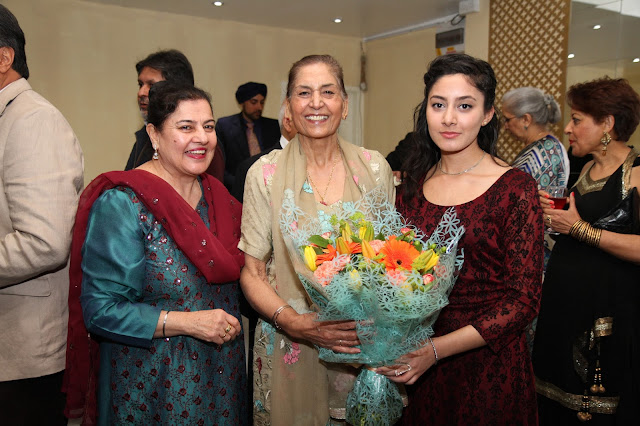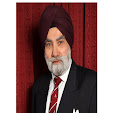Guru Nanak Sahib working at his farm with Bhai Lehna (later Guru Angad)
(Image credit: http://www.mygodpictures.com/category/guru-nanak-dev-ji/)
The Sikhs believe in One Guru Light, the Jyot *.
(*or Joth where th is pronounced as in think.)
In the Bhatt Savaiyay in Sri
Guru Granth Sahib (SGGS) Guru Nanak Sahib is referred to as the embodiment of the
Jyot as follows:
ਜੋਤਿ ਰੂਪਿ ਹਰਿ ਆਪਿ ਗੁਰੂ ਨਾਨਕੁ ਕਹਾਯਉ ॥
Joth Roop Har
Aap Guroo Naanak Kehaayo ||
The
Embodiment of Light, the Lord Himself is called Guru Nanak.
SGGS Ang 1408.
The same Jyot was in the nine Guru-persons after Guru Nanak. Thus, the start
of the Guru-succession process is described as follows:
ਨਾਨਕੁ
ਤੂ ਲਹਣਾ ਤੂਹੈ ਗੁਰੁ ਅਮਰੁ ਤੂ ਵੀਚਾਰਿਆ ॥
Naanak Thoo Lehanaa Thoohai Gur Amar Thoo
veechaariaa ||
You are Nanak, You are
Angad, and You are Amar Daas; so do I recognize You.
(SGGS Ang 968)
According
to Sikh belief, the Jyot now resides in Sri Guru Granth Sahib, the Shabd
or Word Guru.
Together with the
divine concept of Jyot, the idea of Jugat is also introduced in the Guru tradition.
Jyot and Jugat go
together. From this twin- track approach has emerged
a whole-life socially active system which is the miri-piri (temporal-spiritual) heritage of the Khalsa Panth.
Jyot can be conceptualised as a divine Source of Light which shows
the way to the ultimate Reality or Truth (Sacch).
Jyot,
the Light, shows the path to God-centred love (through bhagti and Naam
meditation). It leads the way to the understanding and loving acceptance of the
Divine Law or Hukam Razaaee. It leads
to inner detachment from this life which is a passing phase, and attachment to
the Timeless, Eternal Reality, the Truth (Sacch).
For the Sikhs, Guru
Nanak Sahib is the embodiment of Jyot
as Jyot-roop Guru capable of removing
the duality, the illusion of world-play, in his Sikh. Also, the Jyot-roop is extended from the Guru to
the Sikh as from one lamp is lit another and countless others. In the Sikh
tradition, the emergence (pragteo) of
the Khalsa is seen as the outcome of
that (Guru-Sikh or Aapay Guru-chelaa)
process.
There are references
in SGGS of Har jan becoming one with Har i.e. when the devotee of Waheguru meditates
on the Qualities of Waheguru he or she merges with Waheguru. The duality of
seeing the Creator as distinct from creation is removed. Jyot teaches us One-ness of the Creator Being and the created: to
see God in all.
Ultimately, the Jyot is Waheguru, the Timeless and
Wondrous Enlightener described by Guru Nanak Sahib in his founding creed, the Mool Mantar.
So, what is Jugat? Literally,
Jugat means the way or the method.
What is the jugat of doing or
achieving something? It refers to the
process. Following inner freedom from self-centred attachment, Jugat, re-engages a Sikh with this life
in the Guru’s way. It is the way or method of living shown by the Guru.
Jyot frees or disengages the Sikh from the duality of life due to
self-centricity (haomai) and then, in
that free state of mind of inner detachment, Jugat re-engages the Sikh
through social activism to serve the Creater and the created.
Jyot and Jugat twin-track
approach to Sikhi living is a unique
gift of Guru Nanak Sahib.
It was through the
process of Jugat that the Khalsa was revealed in the Guru’s own image
by Nanak X, Guru Gobind Singh. That was the high point of Sikhi tradition on
the Vaisakhi day in 1699.
Jugat has to do with practical Sikhi and the related processes and
procedures.
The ten Guru persons
were the embodiment of both, the Jyot
and Jugat:
ਜੋਤਿ ਓਹਾ
ਜੁਗਤਿ ਸਾਇ ਸਹਿ ਕਾਇਆ
ਫੇਰਿ ਪਲਟੀਐ ॥
Jyot Oha Jugat saae Seh kaaeiaa faer
palatteeai
The
Guru-persons shared the same Guru Light and the same way (method); only the
King [Nanak] changed His body. (Sri Guru Granth Sahib Ang 966)
Sometimes, due to
lack of clarity of Jugat, divisions
are created amongst the followers of the same path (or panth) of Sikhi.
Today, there is need
to remind ourselves what Guru’s Jugat
means. There are some who ignore this
essential component of Sikh living, either through ignorance or by design. For
most, there is no problem with the Jyot
aspect of Guru Nanak, but for some, the Jugat
aspect of the Guru, passed on to the Khalsa Panth by Guru Gobind Singh, causes
problems.
The Jugat and Jyot linked miri-piri (temporal-spiritual) tradition
symbolised by the institution of Sri Akal Takht Sahib becomes politically inconvenient
for some. The Sikh Reht Maryada – the
Code of Sikh Conduct and Conventions – evolved by the Khalsa Panth, causes
problems also.
Without
a study of the lives of the ten Guru-persons who represented the same Jyot-Jugat of Guru Nanak and who progressed
the Guru’s mission, it is not possible to interpret the divine Message of Sri
Guru Granth Sahib which is both, universal and also specific to the Sikhi way of life evolved over the
centuries. In the Sikh tradition, the lessons taught by the ten Guru-persons
through own lives regarding Jugat
(lived Sikhi) cannot be ignored.
Any
study of Sikh ideology and tradition would be incomplete without understanding the
inseparable Jyot-Jugat attributes of The One Guru. Reference to the Word Guru, the SGGS,
for guidance also requires reference to the Jugat
for practical interpretation. This was taught in simple steps by the ten Guru-persons
up to the revelation of the Khalsa Panth, the high point of lived-Sikhi
tradition.
When
the teaching period of the Jyot-Jugat
Guru through ten Guru-persons was over, the Jyot
passed on to the Eternal Shabd-Guru,
Sri Guru Grath Sahib, while the Jugat
resided in the collective body of the Khalsa Panth, which became Guru Roop Khalsa in the presence of Sri
Guru Granth Sahib. That was the final Command of Nanak-Jyot, Guru Gobind Singh.
The
Jugat resides in the Khalsa Panth.
The Jyot in Sri Guru Granth Sahib
guides individual and collective Sikh living through the Khalsa Panth. That is
the twin track approach to the Guru, when seeking guidance.
Any
other approach would lead to multiple, and sometimes conflicting,
interpretations of Shabd Guru, Sri
Guru Granth Sahib. We see that happening today.
There
are obvious practical implications of the above Jyot-Jugat approach to Sikhi
living. When we feel that we have lost our way then we seek guidance from Sri
Guru Granth Sahib. However, Guru Gobind Singh ji’s injunction is that correct
guidance or interpretation of the Shabd
Guru is only possible at collective Khalsa level. There are those today who
would ignore or even deny that injunction.
The
ray of hope is that there are others pursuing the Sarbat Khalsa tradition of collective decision making to revive the
Khalsa processes for the future guidance of the Panth.
The
Guru’s Jugat was taught over more
than two centuries from 1469, the year of the arrival of “Jyot Roop Har Aap”, Guru Nanak Sahib. The lessons
taught by the Jyot-Jugat Guru-persons
over that period as part of Sikhi
tradition, cannot be ignored.
The Panthic Sikh Reht Maryada – The Code of Sikh Conduct and
Conventions
– is the Jugat
derived collectively by the Khalsa Panth from Sri Guru Granth Sahib as
interpreted through the lives and teachings of the Guru-persons from Guru Nanak
Sahib to Guru Gobind Singh. The definition of a Sikh in the Sikh Reht Maryada includes belief in the
“Ten Gurus, from Guru Nanak Sahib
to Guru Gobind Singh Sahib” and “The utterances and teachings of the ten
Gurus”.
Sikh
tradition is based on Simran or
constant God awareness through meditation on the Jyot, which leads to the desire to serve the Creater Being by
serving His creation.
It
leads to the objective of halemi raj,
a just regime in which no one inflicts pain on another. It leads to willing
sacrifices to oppose tyrannical regimes. Today it is leading Sikhs to care for
the environment and the planet, the Mata
Dharat Mahat – the Great Mother Earth – and to responsible world
citizenship.
The
Sikh tradition is derived from Guru-Jugat
or way of living. Understanding of the Jyot-Jugat
Sikhi approach is a pre-condition to the interpretation of Gurbani when seeking
guidance from Sri Guru Granth Sahib.
Gurmukh Singh OBE
(Principle Civil Servant ret’d)
E-mail: sewauk2005@yahoo.co.uk
© Copyright Gurmukh Singh (U.K.) Please
acknowledge quotations from this article
Articles may be published
subject to prior approval by the author.






































